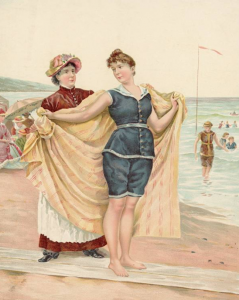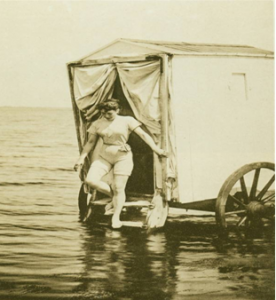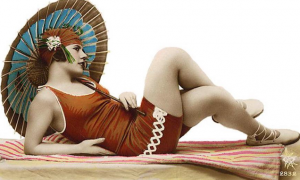Feminist movement changes swimsuit design-history
The changes in the 20th century’s swimwear are closely related to the feminist movement. After most women in Europe and the United States give women equal social status and voting rights, women are free to engage in more outdoor activities. They are thus freed from the various norms imposed on them in the past. Women’s fashion has revolutionized this era. In addition to being more convenient for women to bathe in the bathing suits, the bathing suits have also shown that women are not in a position to speak the same language and invest in society.
The period from 1870 to 1900 was a turning point in the history of women’s swimwear. The style was still the same, but it was becoming simpler and simpler. The women still wore a corset under the womens bikinis sale—a sleeve with sleeves. Leggings, similar to children’s pajamas, woven knitwear.
It was only accepted by fashion critics in the 1920s. The government’s legislature has strictly prohibited such “liberal” clothing through laws that require swimsuits to cover body parts from the neck to the knee. Some women are fined for not wearing stockings, shoes or long skirts.
Women’s swimming became the Olympic Games project for the first time in 1912. Fanny Durac, wearing a sleeveless one-piece swimsuit with half-length trouser legs, came out on top of many projects. Australian-born female womens bikinis sale Annette Kellerman also broke the rules. She was arrested in Boston in 1907 for wearing a bold one-piece swimsuit.
In the early 1920s, the economic affluence of European and American countries led people to pursue life enjoyment. Generally, the “sea-air craze” has become a sought-after thing for the middle class. The wealthy young people are either rushing to the beach to learn swimming or performing Sea bath.
The nylon clothing manufacturer Jantzen created a revolutionary new bathing suit material and established a backwards swimwear style at that time. It completely abandoned the use of waterproof rayon fibers that used cotton, felt, or even no elasticity, and changed it to high elasticity. High-permeability, low-absorbent nylon fabrics are more personal, easy to wear, and lightweight swimwear.
These one-piece mini-skirts and two-piece vests and flat-bottomed shorts not only improved the safety of female swimmers, but also greatly increased the attractiveness of women’s swimwear, and helped women’s social status from the side. One.
A Sexy And Tasteful Illustrated History Of Women’s Swimwear
From string bikinis to high-waisted bottoms and cutouts, bathing suit options are endless these days — patterns and styles exist for everyone and every body type.
But that wasn’t always the case. The swimwear we recognize today didn’t really emerge until the early 1900s, and as the following images show, women’s swimwear has definitely come a long way since then:
In the early 1800s people began to flock to beaches for sunny (and water-filled) amusement, which called for water-activity appropriate clothing.
In that time, modesty was key. Women wore long bathing dresses with weights to hold down the dress in the water and bloomers or stockings.

Bathing machines (seen above) were designed to protect the modesty of bathers. Pulled to the edge of the sea by horses, they were moved according to the tides. Would-be bathers then could enter the machine at the back fully clothed and emerge in a swimming costume straight into the sea.

In the early 1900s, bathing suits no longer camouflaged the contours of the female body. The heavy fabrics were reduced to show a little more of the woman’s figure and to allow for exposure to the sun.

The main theme of the summer seaside is always the sexy bikini, the sun and the sand, and the beautiful hot sexy bikinis, becoming a beautiful scenery along the beach. Young energy and unrestrained freedom are full of fashionable movements.
A good figure is to brave it out.
